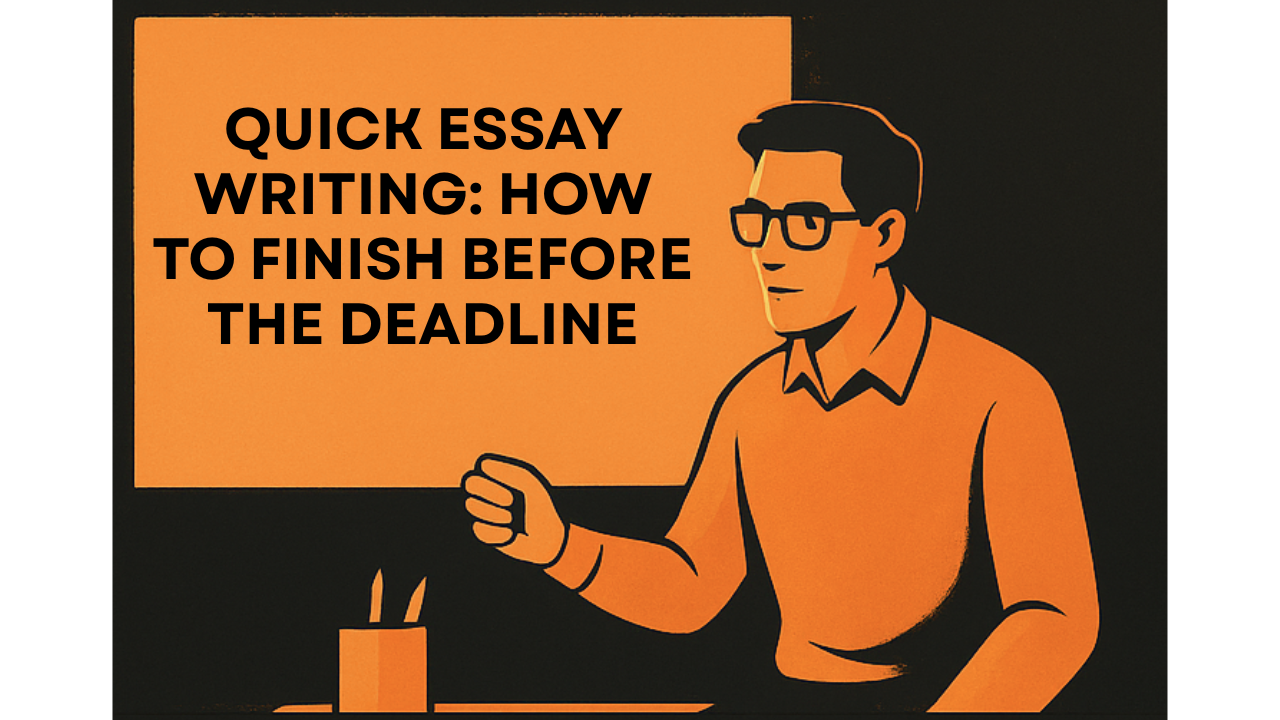Quick Essay Writing: How to Finish Before the Deadline
Facing tight deadlines can turn essay writing into a stressful race. Whether you’re a student or a professional, mastering quick essay writing is essential. Effective time management and strategic writing can reduce stress and help you produce quality work confidently and swiftly. Success under tight deadlines involves understanding assignment requirements, planning efficiently, and crafting a clear thesis. This guide offers steps from outlining and focused research to productivity strategies that minimize distractions. Learn to write well under pressure with tips on editing and proofreading, tailored strategies for different essay lengths, and overcoming common hurdles to excel under tight deadlines.
Understanding the Importance of Time Management
Time management is crucial for writing essays quickly, especially with tight deadlines. By managing time effectively, individuals can prevent getting bogged down in details or spending too long on one section. Improved time management skills allow more time for research, enhancing essay quality.
Breaking down large tasks into smaller, manageable chunks can provide motivation and make it easier to complete essays within limited time frames. Techniques like the Pomodoro method help maintain focus, prevent procrastination, and ensure productivity during writing assignments.
Here’s a simple approach to effective time management for writing:
- Prioritize Tasks: Identify urgent parts of the essay.
- Use a Timer: Try the Pomodoro technique to keep focused.
- Disable Distractions: Turn off social media and phone alerts.
- Set Clear Goals: Break tasks into smaller tasks with timelines.
- Review and Edit: Allocate time to check for grammar and spelling mistakes.
Before starting, prepare mentally with a deep breath and gather materials to build your thesis statement and topic sentences confidently. Manage time wisely to transform urgent essays into quality writing.
Analyzing the Assignment Requirements
Understanding the assignment is essential to crafting a quality essay. Often, students neglect thorough examination of the essay prompt, leading to incomplete or off-topic responses. To avoid this, start by carefully reading and identifying key components of the essay questions. This provides a roadmap for your writing process.
Steps to Analyze Effectively:
- Read the Prompt: Go through the essay prompt multiple times. Highlight critical instructions and keywords.
- Clarify with Professors: If uncertainties arise, don’t hesitate to seek clarification from your professor. They can offer valuable insights and extra resources.
- Discuss with Classmates: Engaging in discussions with peers can provide fresh perspectives and a deeper understanding of the subject matter.
- Prioritize Key Points: Identify and focus on essential elements that need attention in your essay.
By meticulously analyzing the assignment requirements and understanding the expectations, you lay a strong foundation for your essay writing process. This approach will help you avoid common pitfalls like grammar mistakes and spelling mistakes, ensuring your response is comprehensive and on point.
Planning Your Essay Timeline
A well-structured outline is key in simplifying the essay writing process. Break the essay into smaller, manageable sections to prevent feeling overwhelmed and maintain focus. Use the following steps to plan your timeline effectively:
Outline Creation
Begin with crafting a detailed outline to guide your entire essay. This step will clarify your thoughts and streamline the writing process.
Time Management
Allocate specific time blocks for tasks like writing a thesis statement, conducting research, writing, and editing. This will help maintain an organized workflow.
Set Mini-Deadlines
Establish mini-deadlines for each section. This keeps progress steady and ensures completion within the overall deadline.
Incorporate Breaks
Schedule short breaks to recharge. This helps maintain productivity and gives mental rest, preventing burnout.
| Task | Time Allocation |
|---|---|
| Outline | 30 minutes |
| Research | 1 hour |
| Writing | 2 hours |
| Editing | 30 minutes |
| Short Breaks | Intermittent |
Effective planning equips you to tackle any essay prompt with confidence, ensuring a quality essay, even when time is tight.
Crafting a Clear Thesis Statement
A clear and concise thesis statement is vital in essay writing, serving as the backbone of your piece. It guides the writing process and keeps the focus on the main argument.
Quick Guide to Crafting an Effective Thesis
- Define Your Purpose: Clearly state what your essay aims to achieve.
- Be Specific: Avoid vague language; give a precise indication of your essay’s direction.
- Structure Your Ideas: Use the thesis as a roadmap organizing ideas and signaling significance.
- Streamline Your Process: Invest time upfront to simplify the entire essay.
- Revisit and Revise: Refine the thesis as your essay evolves to keep alignment.
By investing time in crafting a robust thesis statement, you’ll ensure readers grasp your argument from the start and your essay unfolds logically.
Creating an Efficient Essay Outline
Crafting an outline is key to efficient essay writing, especially when deadlines loom. An outline provides a clear structure, helping you avoid the intimidation of a blank page.
Benefits of Outlining
- Manageable Sections: Breaks the essay into smaller parts so you can focus on one at a time.
- Coherent Structure: Ensures logical flow and sustained focus.
- Efficient Process: Minimizes wasted time by maintaining direction and clarity.
Steps to Outline
- Start with a Thesis Statement: Define your core argument succinctly.
- List Main Points Hierarchically: Arrange thoughts and evidence.
- Focus on Coherence: Ensure each section supports your thesis.
With an organized outline, you can write with confidence and efficiency—even under tight deadlines.
Conducting Rapid and Effective Research
When a deadline looms, efficient research can be your best ally. Begin by skimming online sources to quickly gather pertinent information. Tools like Google Scholar help find scholarly articles and quotations aligned with your argument.
- Skim Smartly: Focus on relevant content for a fast start.
- Stay Focused: Avoid distractions to organize thoughts and gather data effectively.
- Utilize Unlikely Sources: Keep an open mind for unexpected insights.
- Compile Key Information: Use a table or list to organize points and quotes supporting your thesis.
- Prioritize Speed: Get the basics down first; deepen later.
Following these steps streamlines your process so you can refine into a quality essay.
Writing Techniques for High-Pressure Situations
Writing swiftly near a deadline requires strategy. Turn off distractions, and consider drafting the body first to avoid early writer’s block. Use tools like Grammarly and Hemingway to catch errors quickly so you can focus on content.
| Outline Component | Purpose |
|---|---|
| Thesis Statement | Central argument |
| Main Points | Key arguments or ideas |
| Evidence | Support for each main point |
Quick Tips
- Outline Preparation: Guide your essay with a strong outline and thesis.
- Body First: Write main sections before intro and conclusion.
- Use Writing Tools: Catch grammar and spelling errors fast.
- Minimize Distractions: Keep your environment focused.
- Time Management: Divide work into small chunks with time boxes.
Crafting the Introduction and Conclusion Last
When time is short, drafting the introduction and conclusion after the body improves clarity and cohesion. This reduces pressure at the start and ensures these sections truly reflect your developed arguments.
Overcoming Writing Anxiety and Perfectionism
Set realistic standards and focus on process over perfection. An on-time, imperfect essay often beats a late, “perfect” one. Stay calm, eliminate distractions, and break the task into chunks.
Quick Checklist
- Set realistic standards.
- Submit on time, even if imperfect.
- Stay calm and positive.
- Eliminate distractions.
- Divide the task into chunks.
Implementing Productivity Strategies
Use the Pomodoro technique, detailed task lists, and a clear outline to maintain direction. Eliminate distractions, work in a quiet space, and use writing tools to streamline edits. Plan with breaks, track length with word counters, and mind formatting for platform transfers.
Quick Editing and Proofreading Tactics
Edit and proofread incrementally to catch errors early. Tools like Grammarly and Hemingway improve readability fast. For urgent submissions, professional proofreading can provide a reliable final pass.
Editing Checklist
- Verify essay structure.
- Perform a final proofread.
- Incorporate a bibliography.
- Ensure proper referencing.
Create a focused environment—like a quiet room or coffee shop—to aid concentration during your final review.
Reflecting on Common Writing Pitfalls
Starting without a plan leads to wasted time and anxiety. Build a detailed outline first. Accept that mistakes are part of learning; this reduces last-minute rushing and improves quality.
Quick Pitfall Checklist
- Create a detailed outline before starting.
- Embrace mistakes as learning opportunities.
- Manage time to avoid last-minute rushes.
Strategies for Different Essay Lengths
Allocate time across thesis, outline, research, drafting, editing, and references. Word count, experience, and research depth will affect timing. For longer essays, break paragraphs into sub-sections and remove distractions for better focus.
Writing a 3,000-Word Essay
Manage time efficiently and maintain a clear plan. Expand on ideas during breaks and prioritize content over language at first. Treat the essay as small tasks, plan paragraphs, use relevant research, and stay calm.
Completing an Essay in Under an Hour
Eliminate distractions immediately. If stuck on the introduction, write the body first. Conduct focused research, note structure directly in your document, and divide the essay into sections with set mini-deadlines to ensure timely completion.

